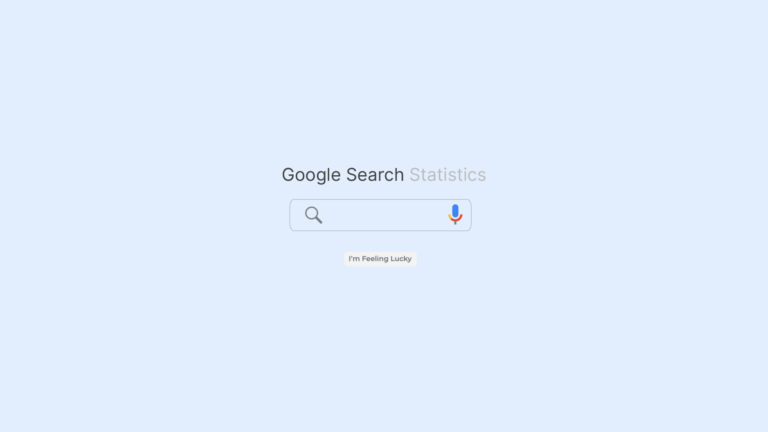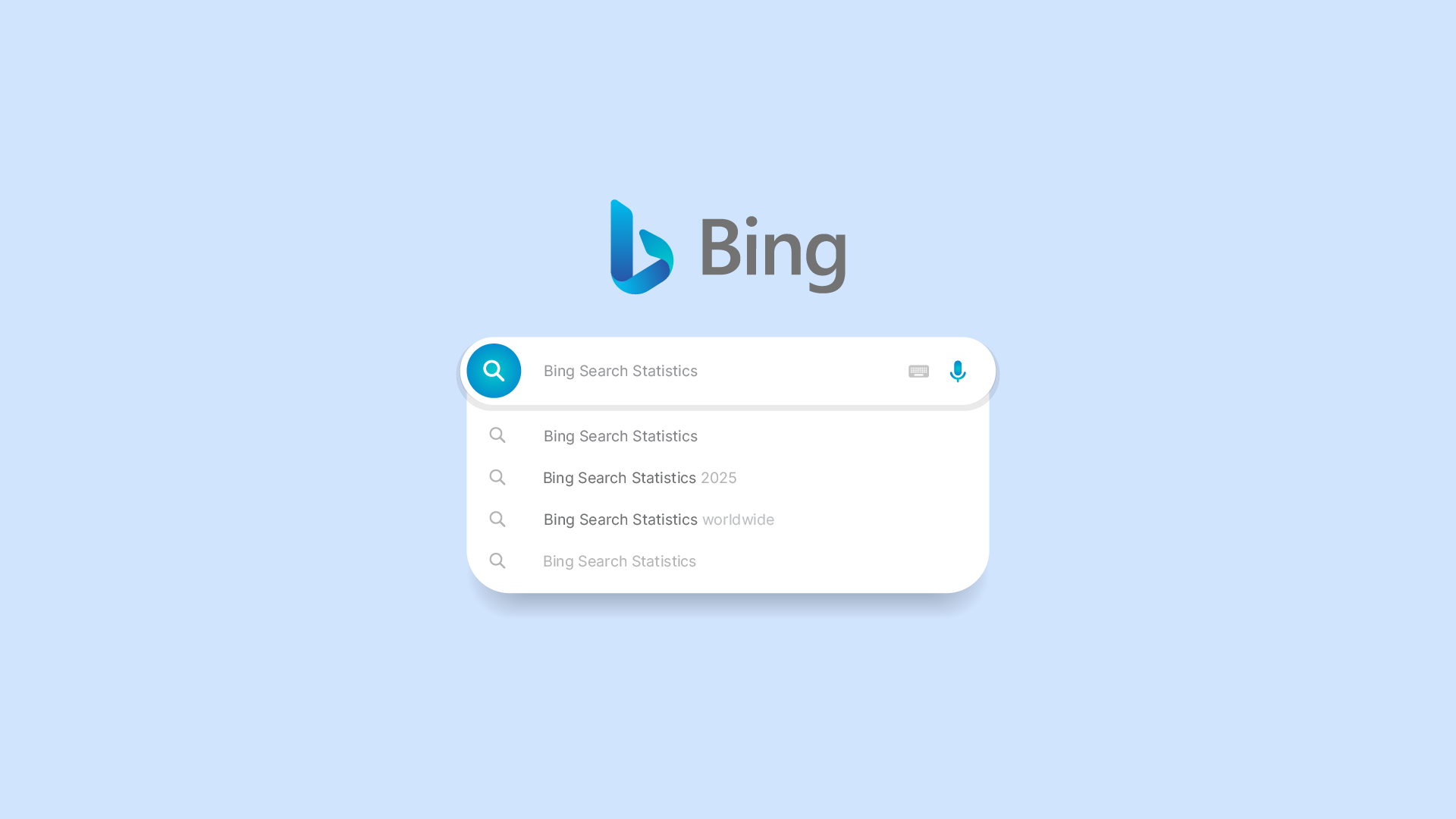When you hear that Google has a 91.47% market share and processes 8.5 billion searches each day, it’s easy to be impressed by the sheer scale. But what does that really mean for businesses, marketers, and regular users? Below, we’ll break down the most important Google search statistics and explain why they matter.
In this post, we’ll dive into the latest Google search trends, user behavior insights, and growth data. The latest Google Search statistics provide valuable insights into user behavior and trends on the platform. Whether you’re a digital marketer, business owner, or a curious internet user, these statistics will help you understand how vital Google is to our online experiences and strategies.
1. Top Google Search Statistics in 2025
Google receives 8.5 billion searches each day.
This shows Google’s massive daily usage. Google users engage with the search engine in various ways, often refining their searches based on initial expectations and the time it takes to make decisions. If you’re a business, you have 8.5 billion chances per day to show up in search results for relevant keywords.
Google has a market share of over 91.47%.
Out of every 10 people searching online, around 9 rely on Google. In the search engine market, competitors like Bing and Yahoo exist, but they pale in comparison to Google’s significant share. Businesses focusing on SEO or paid ads often prioritize Google because of this dominance.
In 2024, Google generated 348.16$307.4 billion in revenue.
| Characteristic | Revenue in billion U.S. dollars |
| 2024 | 348.16 |
| 2023 | 305.63 |
| 2022 | 279.8 |
| 2021 | 256.74 |
Annual revenue of Google from 2002 to 2024 Source: Statista
Google’s platform is profitable not just because of advertising, but also due to products like YouTube, Google Cloud, and more. Most of that revenue, however, still comes from advertising on its search engine. The Google Play Store also significantly contributes to Google’s revenue by offering a vast catalog of mobile applications and maintaining high quality among apps.
Google processes 6.3 million searches every minute.
Every minute is an opportunity for new consumers to find services, products, or information. For marketers, this underlines how quickly trends can shift and why staying visible on Google is crucial.
Globally, 95.37% share of the mobile search market belongs to Google, and 81.95% of the desktop market.
Whether people are on their phones or computers, they mostly choose Google. Google Maps plays a crucial role in local searches on mobile devices, making it essential to optimize Google Business Profiles for better visibility. Optimizing for mobile is especially key since Google’s algorithms prioritize mobile-friendly sites.
60% of all Google search queries are from the United States.
The U.S. is still a massive market, but international audiences shouldn’t be overlooked. Businesses with a global presence can tap into the remaining 40% worldwide.
58% of users aged 25–34 use Google Voice Search daily.
Younger demographics lean heavily on voice. If you want your content to show up for spoken queries, optimize for voice search keywords (often longer, more conversational questions).
Over 90% of all indexed pages get zero traffic from Google.
Simply being indexed doesn’t guarantee visitors. High search rankings on search engine results pages (SERPs) and relevant, high-quality content are essential to capture any of that traffic.
2. Google Search Statistics Worldwide 2024
Google remains the primary search engine around the globe, influencing billions of user decisions and shaping the digital marketing landscape. Understanding general Google statistics can provide valuable insights into user behavior and search practices, illustrating the significance of ranking high on Google’s search engine results pages. As you read these statistics, think about how each data point might affect your approach to search engine optimization (SEO), paid advertising, or content creation.
3. How Many Google Searches Per Day?
8.5 billion searches happen on Google daily.
That is nearly 99,000 searches every second. It implies a vast audience looking for answers at any given moment—an incredible opportunity for anyone publishing helpful, relevant, or entertaining content.
Google.com sees 84.2 billion visits a month globally.
Google Sites, as part of Google’s leading multi-platform web properties, attracts a massive user base, with over 274 million unique visitors as of February 2023. This monthly figure is an indicator of the platform’s scale. If your site ranks high, a fraction of those visits can drive substantial traffic to your pages.
6.3 million searches happen every minute.
In the time it takes to read this bullet, hundreds of thousands of searches will have occurred. Google is a dynamic environment, so frequent updates to your content and SEO strategy can be crucial to remain competitive.
15% of searches each day are entirely new.
People are consistently searching for things that have never been typed into Google before. This means there’s room for innovative or niche content to rank without facing intense competition.
4. Google Search Market Share of 2024
| Search Engine | Market Share |
| 91.47% | |
| Bing | 3.43% |
| Yandex | 1.78% |
| Yahoo | 1.1% |
| Baidu | 0.83% |
| DuckDuckGo | 0.54% |
91.47% of all global searches happen on Google.
Google’s search engine is crucial in determining website visibility and traffic. If your SEO strategy revolves around this search engine’s algorithms, you’re targeting the largest possible audience.
9 out of 10 users choose Google over other search engines.
Although diversifying traffic sources is wise, ignoring Google means missing out on the majority of potential search traffic.
84% of people use Google at least three times a day.
Google is such a routine part of users’ daily lives that repeated brand exposure via search can substantially impact brand recognition and customer acquisition.
5. Most Searched Query on Google in 2024
“YouTube” is the top global query, with over 1.2 billion monthly searches.
Branded searches dominate. People already know YouTube but type it into Google rather than the address bar. Understanding that brand names can be top queries may inform your PPC strategies (bidding on your own brand name to maintain top spot in search results).
“Facebook” follows closely with 867 million monthly searches.
Another example of user habit—often, users search for “Facebook” rather than typing facebook.com.
“Weather” ranks fourth at 512.7 million monthly searches.
Generic queries like “weather” often lead to localized results. This usage pattern highlights the power of Google’s geographical personalization.
6. Most Frequently Asked Question on Google
“Where is my refund?” hits 15.5 million monthly searches.
This reveals that many people turn to Google for time-sensitive, government-related, or financial questions, highlighting how broad and immediate user queries can be.
“How many ounces in a cup?” with 8.6 million monthly searches.
Everyday practical queries dominate user searches. If you run a food or lifestyle blog, this stat shows the evergreen potential of answering common kitchen or household questions.
7. Google Search Statistics by Device
| Device | Global Market Share |
| Mobile Devices | 95.37% |
| Desktop | 85.95% |
95.37% of mobile searches occur on Google.
If you have a mobile audience (and nearly everyone does), your site must be mobile-responsive to rank well.
85.95% of desktop searches are also on Google.
Even on computers, Google remains the default for most people, reinforcing the need to optimize for both mobile and desktop experiences.
76% of smartphone users who search for something nearby visit a business within a day.
Local SEO is powerful. Google Business Profile plays a crucial role in enhancing business visibility and customer engagement. Brick-and-mortar businesses can leverage “near me” or local keywords to drive physical visits and conversions.
8. Google Voice Search Statistics
1 in 5 searches on Google is voice-based.
For every 5 searches on google, 1 is voice search. Voice queries often sound different from typed queries (“What is the best pizza place in downtown Chicago?” vs. “best pizza downtown Chicago”). Adapting keyword strategies to include conversational phrases can improve rankings for voice searches.
Over 500 million people use Google Assistant monthly.
Voice assistants are prevalent. Optimizing your content to answer quick questions can land your site in featured snippets or voice “answers.”
About 58% of people aged 25–34 use voice daily.
Younger audiences, with significant purchasing power, rely on voice. Tailor your marketing strategies for natural, question-based queries to engage these users.
9. Google Lens Search Statistics
Google Lens is used 3,086 times per second.
Visual search is growing. If your business is product-focused, ensure your images are optimized with proper titles and alt tags so that they’re discoverable via visual search.
Google Lens sees 8–12 billion uses per month.
That’s a massive volume of people relying on images to search, shop, or find information. Consistent, high-quality visuals could help you attract a portion of this audience.
Google Image Search indexes around 136 billion images.
It’s an enormous library. By properly labeling your images, you can stand out among the billions.
10. Google Ads Statistics
19% of users click on a Google ad while searching.
Ads can be highly effective. Although most clicks still go to organic results, nearly a fifth of users click on ads if they’re relevant to their query.
Advertisers earn $8 for every $1 spent on Google Ads.
That’s a 700% ROI potential. If you set up campaigns effectively—targeting the right keywords and audiences—Google Ads can be a game changer for marketing.
Global search ad spending reached $316 billion in 2024.
It’s not just big brands pouring money into ads. Small businesses also use them to reach specific local or niche audiences. In 2024, global search platforms earned over US$316 billion in ad revenue, a 12% increase from 2023, as marketers spent nearly US$1.1 trillion on ads worldwide
11. Google Local Search Statistics
46% of monthly Google searches have local intent.
Nearly half of all queries relate to a specific location or region. Local businesses can benefit significantly from SEO strategies that focus on local content, reviews, and location-based keywords.
21% of people in the U.S. use Google daily to find local businesses.
If you have a physical storefront, a local presence on Google can bring consistent daily foot traffic.
78% of local mobile searches result in offline purchases.
People often search locally when they’re ready to buy. If you show up in those results, you have a high chance of converting browsers into customers.
12. Google Search User Behavior Statistics
Only 7% of users open multiple pages to find what they’re looking for.
People typically click on the first result that seems good enough. Ranking in the top few positions is vital to capture this traffic.
23% of users choose the autocomplete suggestion.
Users often trust Google to speed up their search. Search interest is indexed and normalized to provide insights into the relative popularity of topics over time and across different locations. Optimizing for autocomplete can help you appear in user queries before they’ve even finished typing.
0.44% of users navigate to the second page of Google results.
If you’re not on page one, you’re essentially invisible to the vast majority of searchers.
50% of Google searches end in no click.
Featured snippets, knowledge panels, and direct answers often satisfy user queries. While it reduces click-throughs, being the snippet source can still boost brand recognition.
13. Google SERP Statistics
27.6% of all clicks go to the #1 result.
Being in the top spot can mean nearly triple the click-through rate compared to the second position. If you’re second or third, improving your ranking by even one position can significantly impact traffic.
12.3% of search queries include a featured snippet.
A featured snippet appears at the top, often referred to as “Position Zero.” Google Trends is a valuable tool that provides insights into search behavior by showing the popularity of specific topics and terms over time, allowing you to monitor real-time search interests and analyze trends by location. Optimizing your content to appear there can drastically increase visibility.
Leads generated through SEO have a 14.6% close rate.
Organic traffic often consists of users genuinely interested in a topic. SEO leads are more likely to convert than many other marketing channels.
14. Google Search Growth Rate
Currently estimated around 10% annual growth.
Google continues to attract more searches year over year, though the growth rate has stabilized compared to its early exponential leaps.
From 1999 to 2000, it saw a 1000% jump.
Early on, Google expanded at breakneck speed. While that pace isn’t sustainable forever, the fact that it still grows by 10% is remarkable given its already massive scale.
15. Google Search Revenue Statistics
Google generated $79.9 billion in Q1 of 2024.
The consistency of Google’s earnings shows that advertisers and consumers alike continue to rely on the platform.
In 2023, total revenue was $305.63 billion.
Google’s ecosystem—search, YouTube, Cloud, Android, and more—contributes to an ever-rising revenue stream.
Advertising Revenue Breakdown
$206.54 billion from Google websites in 2023 (Search, YouTube, etc.).
Most of Google’s money still comes from ads on its primary platforms. If you’re debating where to put your advertising budget, Google’s scale is hard to ignore.
$31.31 billion from Google’s network sites in 2023.
Google’s display ads (shown on partner sites) are also significant but still smaller than direct search ads.
Of its $212.87 billion revenue in 2024, advertising remained Google’s primary revenue source, with 77.8% of revenue coming from ads on Google properties and YouTube, and the Google Cloud segment contributed 10.8%.

Final Thoughts: Google Receives 8.5 Billion Searches Each Day
Whether you’re optimizing for organic search, investing in ads, or simply curious about how the internet’s largest search engine works, these statistics highlight Google’s phenomenal reach and influence.
Recognizing the details behind these numbers can help shape your digital marketing strategy, customer outreach, and even user experience decisions on your website.
If you want to be found online, understanding and leveraging Google’s search dynamics is crucial—especially since so many users rarely venture beyond page one.
FAQs on Google Search Statistics
How can you see how many times something has been googled?
To see how many times a specific term has been googled, you can use tools like Google Trends. This platform allows users to explore search interest over time and across different regions. By entering a search term, you can view its popularity and compare it with other terms to gauge trends.
Are 46% of all Google searches local?
Yes, approximately 46% of all Google searches have local intent. This statistic highlights the importance of local SEO for businesses aiming to attract nearby customers through search results.
How to check statistics in Google?
To check statistics in Google, you can utilize Google Analytics for detailed insights into website traffic, user behavior, and conversion rates. Additionally, Google Search Console provides data on search performance, including clicks, impressions, and average position in search results.
How to get started with Google Trends?
To get started with Google Trends, visit the Google Trends website. You can enter a search term or topic to explore its popularity over time, compare it with other terms, and analyze data by location and category.







